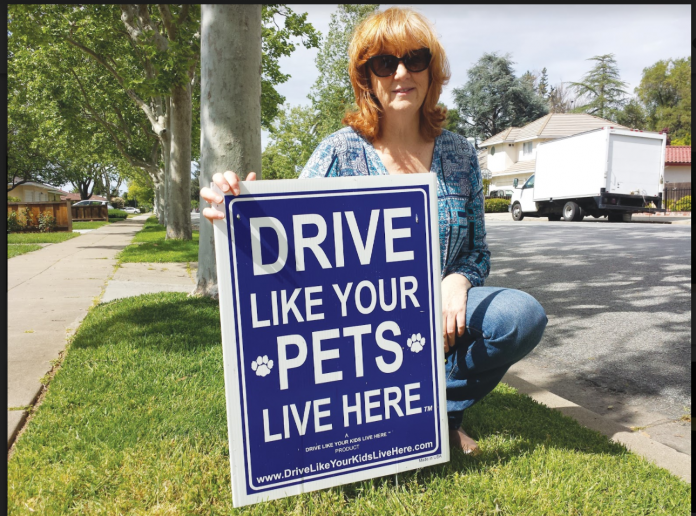Frances the cat was nine years old and ailing when she was hit and killed by a car in front of her Gilroy home.
Now her owner hopes the loss of her rascally but beloved feline might help convince drivers to reduce speeds in the city’s residential neighborhoods.
“It would be nice if people could be more careful and not be in such a hurry,” said Annie Palmer.
And to remind them of what’s at stake Palmer, who works in the insurance industry, has placed a bright blue sign on her lawn that’s clearly visible to drivers on Hanna Street a block north of the Gilroy police headquarters.
It says, “Drive Like Your Pets Live Here.”
Up the street, two lawns have bright red signs whose messages could not hit closer to home. They read, “Drive Like Your Kids Live Here.”
Linda Williams installed one of them, and for good reason, she said.
“It’s not unusual at all to see a car doing 50 miles an hour” on the street, said the owner of The Nimble Thimble Quilt Shop downtown and a relative newcomer who so loves Gilroy she not only moved to the city but bought a business.
Elsewhere in the city the same signs, made by a Connecticut company, are in other neighborhoods. It’s all part of an effort that grew out of frustrations felt by Palmer’s boyfriend, Gary Walton, about speeding cars and the city’s apparent inability to deal with it effectively.
“I have had my battles with city” over speeding and street designs that he believes encourage higher speeds, said Walton.
Walton is a Gilroy business owner and President of the Gilroy Downtown Business Association, a role he took on recently after years of advocating for the city’s historic commercial district and Gilroy in general.
He has actively sought to expand the association’s footprint to include advocacy for downtown residential areas, neighborhoods whose residents can walk to shops along Monterey Road and its feeder streets and add vitality to the downtown.
He and Palmer were driving in Santa Cruz a couple of years ago when he saw the bright red Kids signs and thought, “Wow, that is a good idea,” he said.
By that point, he had attended a number of coffees with the mayor where speeding was a constant complaint.
“The standard responses (from the city) were, ‘We can’t be everywhere. We don’t have enough police officers. Traffic engineers say we don’t need stop signs. So, what do you want us to do?’” Walton said, adding, “Nothing ever changed.”
Neighborhoods can do things themselves, he said, and the signs are one of them.
“So, I went on line and bought them,” he said, at the website, www.divelikeyourkidslivehere.com.
And when Palmer’s cat was killed, he went back online and bought some of the company’s blue signs about pets.
Company co-founder Petulia Pugliares in Wethersfield, CT, said that in the almost seven years since her company started they’ve sold about 75,000 of the kids signs and about 10,000 of the pet signs, internationally.
It began when she was almost hit while walking her dog; a homemade sign she put on her lawn got her neighbors’ attention and it caught on and grew, she said.
According to her website, about 70 percent of children killed or injured by motor vehicles are hit within blocks from their homes and vehicle crashes were the leading cause of death for age 11 and ages 16-24 in 2014.
Walton has distributed the signs around town, although often after being placed they go missing, he said.
Williams was chatting with neighbors one day when a boy on a bike stopped and grabbed her sign, she said. He would have taken it if her neighbors had not ordered him to return it, she said.
And Williams said it’s not just regular drivers who speed on Hanna Street, it’s also police in cars responding to emergencies from the nearby police station. They travel at “breakneck” speeds, she said.
At the Gilroy Police Department, Sgt. Jason Smith said officers always use sirens and lights, drive safely and obey the vehicle codes, but are allowed to exceed speed limits, even in residential areas, when responding to emergencies.
Traffic Sgt. Wes Stanford said his unit now uses a tracking system for all complaints and target speed enforcement to areas most prone to violations.
Radar equipment also provides data about when infractions occur and their severity, he said, adding to his unit’s ability to focus resources on areas of demonstrated need.
One problem, he said, is that often speed violations happen at the same time that traffic officers, including three motorcycle units, are deployed at schools, particularly the high schools, which are given greater attention, he said.
“It can be a challenge,” he said.
Palmer is not sure how her cat was killed, it might have been the cat’s fault or the driver’s fault, she even blames herself for using poor judgment in letting her pet, a rescue from the San Martin Animal Shelter years ago, out so soon after major surgery.
Frances was a well-known animal “character” in the neighborhood, as much for her demands to be fed by neighbors as for her habit of marking her territory, even when it was Palmer’s car windshield.
Not long before she was hit, Frances was in a fight that left one eye so badly injured she needed a veterinary eye specialist and constant attention. The eye could not be saved, and Palmer still wonders if impaired vision might have contributed to her pet’s death.













